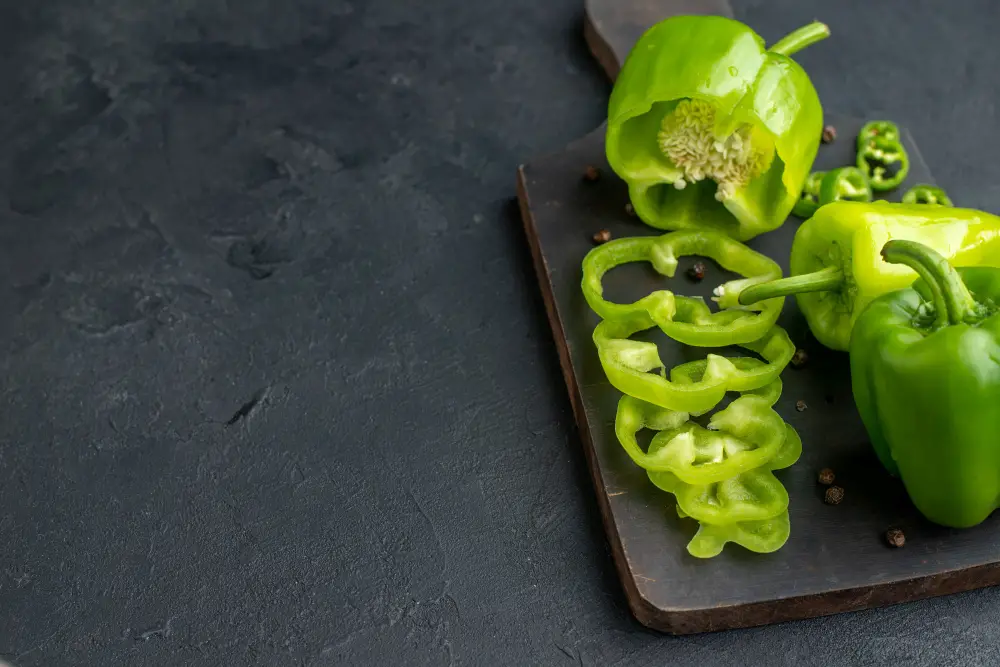Bearded dragons, as exotic as they are, require a well-balanced diet to ensure their health and longevity. Like any pet, they have certain foods that are beneficial for them and others that might not be as suitable for regular consumption.
Bell peppers, while nutritious, fall into a unique category when considering their dietary impact on bearded dragons. This article delves deep into the relationship between bell peppers, specifically green and red varieties, and the diet of bearded dragons, examining both the benefits and the limitations.
Understanding the Limitations: Why Bell Peppers Aren’t a Daily Food for Bearded Dragons?
Bearded dragons have unique dietary needs that are distinct from many other pets. While bell peppers are indeed nutritious and can be a delightful treat, there are several reasons they shouldn’t be the primary food source for these reptiles:
- High Water Content: Bell peppers, particularly the red and green varieties, contain a significant amount of water. When consumed in large quantities, this can lead to a waterlogged diet. While hydration is essential, receiving too much water from food sources can result in soft, runny stools or diarrhea in bearded dragons. This can be particularly concerning because persistent diarrhea can lead to dehydration, a paradoxical yet concerning health issue.
- Nutritional Imbalance: Bell peppers, though rich in certain vitamins, lack the comprehensive nutritional profile bearded dragons need. These reptiles require a good balance of calcium, phosphorus, protein, and other nutrients. While bell peppers can offer some vitamins like Vitamin C and A, they don’t provide enough of the essential nutrients pivotal for bearded dragon health. Relying heavily on them can lead to nutritional deficiencies over time.
- Calcium-to-Phosphorus Ratio: This is an essential aspect of the bearded dragon’s diet. A balanced calcium-to-phosphorus ratio ensures proper bone health and growth. Bell peppers have a skewed ratio, with phosphorus levels that can interfere with calcium absorption when fed in large quantities. Over time, this imbalance can lead to metabolic bone disease, a common yet serious ailment in pet reptiles.
- Potential for Pesticides: Like many fruits and vegetables, bell peppers can be treated with pesticides. If these are ingested by bearded dragons, it can lead to toxicity. While washing can reduce some residue, not all pesticides are easily removed by cleaning. This underscores the importance of sourcing organic peppers if they’re to be included in the diet.
- Digestibility: The outer skin of bell peppers can be tough and may pose some digestive challenges for bearded dragons. While they can process it, there’s a risk of impaction if the pieces are too large or if the dragon eats too much of it.
- Variety is Key: Just as humans thrive on a varied diet, so do bearded dragons. Relying too heavily on one food source, even if it’s nutritious, denies them the range of nutrients available from other foods. It’s always beneficial to rotate the types of vegetables, fruits, and protein sources they receive to ensure a well-rounded diet.
while bell peppers can certainly be included in a bearded dragon’s diet, they should be seen as an occasional treat rather than a staple. Awareness of these limitations ensures that bearded dragons receive varied, balanced nutrition, promoting their overall health and well-being.
Green Peppers and Bearded Dragons: A Dietary Exploration
Green peppers, a staple in many human dishes, can be introduced to a bearded dragon’s diet but with caution. They are lower in sugar compared to their red counterparts and can be a refreshing treat occasionally. Rich in Vitamin C, they can boost the immune system of the dragon. However, due to their aforementioned limitations, they should be served in moderation. Too many green peppers can also throw off the calcium-to-phosphorus ratio, which is essential for bone health in bearded dragons.
The Role of Red Peppers in a Bearded Dragon’s Meal Plan
Red peppers, while similar in many respects to green peppers, have a distinct nutritional profile. They are higher in vitamins A and C compared to green peppers. The presence of beta-carotene, which gives them their bright red hue, is beneficial for the overall health of the dragon. However, they also contain more sugar. This means that while they can be a delicious treat, they should be given less frequently than green peppers. Again, the key is moderation to ensure that the bearded dragon gets variety without compromising on essential nutrients.
Best Practices for Introducing Bell Peppers to Bearded Dragons
When introducing bell peppers, or any new food, to a bearded dragon’s diet, it’s essential to do so gradually. Start by offering small amounts, finely chopped, and observe your pet for any adverse reactions. Always ensure the peppers are fresh, thoroughly washed, and free from pesticides. Remove any seeds and avoid feeding the stems. Organic peppers are a preferred choice as they have a lower risk of containing harmful chemicals. Over time, as you gauge your dragon’s preference and tolerance, you can adjust the frequency and serving size.
Concluding Thoughts on Can Bearded Dragons Eat Bell Peppers
Can Bearded Dragons Eat Bell Peppers, both green and red, can be a part of a bearded dragon’s diverse diet but should not be the primary food source. Like with any food, variety is vital, and moderation is key. By understanding the nutritional benefits and potential limitations of bell peppers, owners can make informed decisions that contribute to the health and happiness of their bearded dragons.

